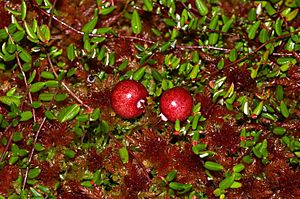Vaccinium oxycoccos facts for kids
Quick facts for kids Vaccinium oxycoccos |
|
|---|---|
 |
|
| fruit on a bed of Sphagnum rubellum | |
| Conservation status | |
| Scientific classification | |
| Genus: |
Vaccinium
|
| Species: |
oxycoccos
|
| Synonyms | |
|
Synonymy
Vaccinium oxycoccus Linnaeus
Oxycoca vulgaris Raf. Oxycoccus oxycoccos (L.) MacMill. Oxycoccus palustris Pers. Oxycoccus quadripetalus Schinz & Thell. Oxycoccus quadripetalus Gilib. Oxycoccus vulgaris Hill Schollera europaea Steud. Schollera oxycoccos (L.) Roth Schollera paludosa Baumg. Schollera palustris Steud. |
|
The Vaccinium oxycoccos is a type of flowering plant. It belongs to the heath family, which includes many berry-producing plants. This plant is often called the small cranberry. You might also hear it called bog cranberry or swamp cranberry. In Britain, people simply call it cranberry.
This plant grows in cool northern areas around the world. You can find it in northern Europe, northern Asia, and northern North America.
Contents
What Does the Small Cranberry Look Like?
The small cranberry is a low-growing shrub. It has stems that spread out like vines and can grow roots as they touch the ground. Its leaves are tough and shaped like a spear. They are about 1 centimeter (0.4 inches) long.
The plant's flowers grow on stalks that hang down. These stalks are a few centimeters tall. The flowers are white or pink. Their petals bend backward, away from the center. The fruit is a red berry. When it's young, it has spots. The berries can grow up to 1.2 centimeters (0.5 inches) wide.
This plant works with tiny fungi called mycorrhizae. These fungi help the plant get nutrients from the soil. The small cranberry mostly makes new plants from its stems, not from seeds. This is called vegetative reproduction.
Where Does the Small Cranberry Grow?
The small cranberry is very common in cooler parts of the northern world. It likes moist or wet soils. These soils usually have low amounts of nitrogen. They also have a high water table, meaning the ground is often soaked with water.
This plant is a sign that you are in a certain type of wet area. It often grows in bogs and fens. These are wet, spongy areas found in forests. Bogs have very acidic soil with few nutrients. The plant's mycorrhizae help it find food in these tough conditions. Fens have slightly less acidic soil and more nutrients. You can often spot the small cranberry growing on raised bumps of Sphagnum moss.
How Does the Small Cranberry Live with Other Plants?
In North American forests, the small cranberry shares its home with many other plants. These include leatherleaf and bog rosemary. Other neighbors are bog laurel and the pitcher plant. You might also see Labrador tea and cloudberry.
Other plants in this habitat are rhodora and glossy buckthorn. Tiny sundew plants and cottonsedge also grow here. Various types of sedge and lichen are common too. The small cranberry can easily grow in bog areas that have recently had a fire. It survives fires because its underground stems, called rhizomes, are protected.
Uses of the Small Cranberry
The berries of the small cranberry are safe to eat. Native American communities have used them for both food and medicine for a long time. For example, some Iñupiat people cook these cranberries. They mix them with fish eggs and blubber.
See also
 In Spanish: Arándano palustre para niños
In Spanish: Arándano palustre para niños


